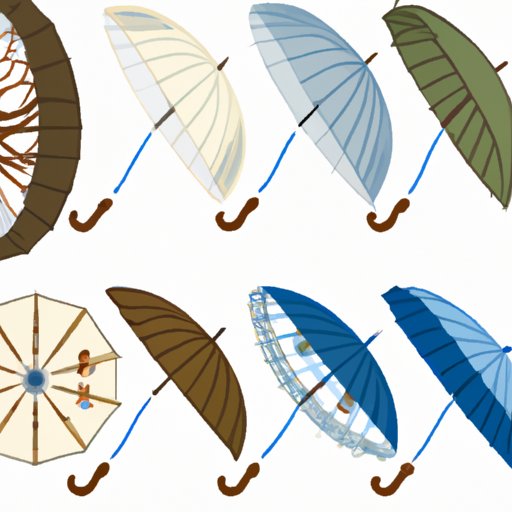Introduction
An umbrella is a device used to protect oneself from rain, sun, or wind. It is typically made up of a fabric canopy supported by ribs, which are connected to a central pole. The history of the umbrella is a fascinating one, as it dates back centuries and has gone through many iterations to reach its modern form today.
A Historical Look at the Invention of the Umbrella
The umbrella has a long and storied history, with its earliest known origins dating back to ancient Egypt. According to archaeological evidence, umbrellas were used by Egyptians as far back as 3500 BC to shield themselves from the sun. These umbrellas were constructed from palm leaves and were held up by a wooden stick.
Since then, the umbrella has evolved over the centuries, with different cultures around the world creating their own versions of the rain cover. For example, in China, umbrellas were used as early as 1100 BC, while in India they were first seen during the Gupta period (320-550 AD). In Europe, umbrellas began to appear in the 16th century, with the most popular being collapsible umbrellas, which could be opened and closed with ease.

A Timeline of the Invention and Development of the Umbrella
The first known designs of the umbrella date back to the ancient Egyptians, who constructed them from palm leaves. Over time, the design of the umbrella evolved and changed, with different cultures introducing their own variations. Here is a timeline of the development of the umbrella:
- 3500 BC – The first umbrellas are constructed in Egypt, using palm leaves and a wooden stick.
- 1100 BC – Umbrellas become popular in China, often being used as a status symbol.
- 320-550 AD – The first umbrellas are seen in India during the Gupta period.
- 16th Century – Collapsible umbrellas become popular in Europe.
- 1750s – The parasol, a type of umbrella designed for sun protection, becomes popular in Europe.
- 1852 – The first automatic umbrellas are invented in London.
- 1920s – The first folding umbrellas are created.
- 1950s – The first golf umbrellas are produced.
- 1970s – Telescopic umbrellas become popular.
- 1980s – Windproof umbrellas are introduced.
- Present Day – A variety of different umbrellas are available, including those designed for specific uses such as beach umbrellas and patio umbrellas.
How Did People Stay Dry Before the Invention of the Umbrella?
Before the invention of the umbrella, people had to find other ways to stay dry when it rained. Ancient solutions included animal hides, tree branches, and even clay pots. In some cases, people would use clothing items such as hats or cloaks to protect themselves from the elements.
In addition to these methods, people also used a variety of different devices to keep themselves dry. According to historian Pierre Marais, “In the Middle Ages, it was common to see people carrying large wooden shields or pieces of canvas to keep the rain off.” In some cases, people would also use umbrellas made from paper or cloth, although these were not as effective as modern umbrellas.

The Impact of the Invention of the Umbrella on Everyday Life
The invention of the umbrella has had a profound impact on everyday life. It has allowed people to stay dry in inclement weather and protect themselves from the sun’s harmful rays. In addition, the umbrella has become a fashion statement, with a variety of different styles available to suit any taste.
Furthermore, the invention of the umbrella has had a major impact on society. According to historian Sarah Price, “The umbrella has been used as an emblem of authority since the 18th century, with rulers and politicians often seen carrying them in public.” This has led to the umbrella becoming a symbol of power and influence in many cultures.
What Was the First Umbrella Ever Created?
The first known umbrellas were created by the ancient Egyptians, who constructed them from palm leaves and a wooden stick. However, the first umbrellas to gain widespread popularity were collapsible umbrellas, which were invented in the 16th century. These umbrellas were made from a variety of materials, including silk, linen, and whalebone. They quickly became popular among royalty and the upper classes, due to their convenience and portability.
The first automatic umbrellas were invented in London in 1852, followed by the first folding umbrellas in the 1920s. Since then, umbrellas have continued to evolve, with new designs and features being added over the years. Today, a wide variety of umbrellas are available, from simple rain umbrellas to specialized umbrellas designed for specific activities such as golfing or beachgoing.
Conclusion
The invention of the umbrella has had a major impact on everyday life, allowing people to stay dry in inclement weather and protect themselves from the sun. It has also become a symbol of power and influence, with rulers and politicians often seen carrying them in public. Over time, the umbrella has evolved from its ancient origins to its modern variations, with a variety of different designs and features now available.
The invention of the umbrella has truly revolutionized the way we think about staying dry in bad weather, and its importance cannot be overstated. So the next time you open your umbrella to protect yourself from the rain, remember the long and storied history behind this iconic rain cover.
(Note: Is this article not meeting your expectations? Do you have knowledge or insights to share? Unlock new opportunities and expand your reach by joining our authors team. Click Registration to join us and share your expertise with our readers.)
